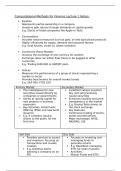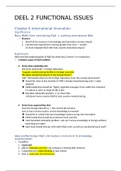Purchasing Strategy Session 1
What is strategic purchasing?
Carr and Pearson (1999, p.499): “The process of planning, evaluating, implementing and
controlling strategic and operating purchasing decisions.”
Yeng (2008, p.490): “a long-term, planned effort to create a capable supplier base and
leverage the benefit of supply management.”
Cousins et. Al (2008) conclude that there are three concepts central to strategic
purchasing:
1. It affects the scale and scope of an organization’s activities over the long term
2. It is about being responsive to changes in the external environment
3. It is about aligning activities with strategic resources and capabilities.
Supply Base vs. Supply Chain
Difference Purchasing and Supply management (due to Monczka et al. 2009)
Purchasing: functional group (e.g. a formal entity on the organizational chart) as well as a
functional activity (i.e. buying goods); performs many activities to ensure it delivers
maximum value to the organization e.g. supplier identification + selection etc., referred to
as doing “the five rights”: right quality, quantity, time, price, source
Supply management: not just new name for purchasing, but meant to be a strategic
approach to planning for and acquiring the organization’s current and future needs
1
, through effectively managing the supply base, utilizing a process orientation in
conjunction with cross-functional teams (CFTs) to achieve the organizational mission
The ‘strategic’ role of purchasing in organizations (Eatough 2014)
“The term procurement itself has a very administrative connotation: It’s associated with
buying “stuff” for the lowest prices possible.”
“Procurement doesn’t register on the C-suite’s radar in a manner proportionate to its growing
importance within the organization (increasing portion of revenue is directed toward
externalized, supplier-driven costs > 70%), and most procurement departments are neither
ready nor empowered to take on their new responsibilities."
Reasons:
1. An unproductive fixation on cutting costs: Improvements to shareholder value come from
delivering corporation’s objectives, not from decreasing spending.
2. Organizational isolation: procurement teams are often isolated from the functions they
serve + the markets they engage not fluent in he nuances of the business + lack
expertise and authority to challenge or influence spending decisions frustration sales
and revenue-generating front lines even further isolation
3. Glacial processes e.g. long tendering processes which are not acceptable in today’s fast-
moving and interconnected environment
4. Acting without inquiry: linked to organization isolation, procurement people are not
programmed, encouraged or incentivized to do much other, besides many lack the training
and skills requests are taken at face value without second though
How can this be redeemed? (Eatough 2014)
- Reassess and clearly define the role of procurement – process-oriented or savings-
obsessed function?
- Change the way procurement is measured (see below)
- Determine whether the current cast of procurement executives has the required skills and
abilities through training, recruitment or partnership with third parties
- Give procurement teams incentives to create a welcoming atmosphere for suppliers
suppliers should be beating down the door to get their goods and services into the
organization + driving force for innovation + viewed as critical partner in company’s
success
How should purchasing organize itself for a strategic contribution to the firm?
(Rozemeijer et. al 2003)
- Corporate Purchasing Synergy: Any benefit resulting from any form of cooperation
between two or more business units belong to the same cooperation. Example benefits:
o Cost savings
o Better relationship with suppliers
o Better use of the supplier’s expertise etc.
2
,3
, Conceptual model
- Shall explain the nature and extent of purchasing synergetic activities in large
corporations
- Corporate coherence: The extent to which the different parts of the cooperation operate
and are managed as one entity e.g. similar management styles, culture, structure across
business units reflects a rather high corporate coherence.
- Purchasing maturity: Among others related to the level of professionalism in the
purchasing function as epressed in status of the function, role and organizational status of
the purchasing department, availability of purchasing information system, quality of the
people involved in purchasing, and level of collaboration with suppliers.
- Business environment (e.g. competitive pressure, changes in the industry structure and/or
technology) are not major driver for corporate purchasing synergy. Rather play an indirect
role changes in corporate coherence and purchasing maturity.
- Barriers e.g. lack of a clear corporate strategy, lack of an integrated corporate structure,
weak corporate culture
Conclusions for creating a corporate advantage through purchasing (Rozemeijer)
1. Align purchasing initiatives with corporate strategies
2. Do not focus exclusively on negotiating corporate contracts for
common commodities and services (pushing too much is counter-
productive; business unit managers are profit- and loss-responsible, they will be very
careful not to become too dependent on others for their purchasing decisions.) Related to
Eatough’s (2014) observation that CPOs should change they way that procurement is
measured, connecting its objectives to those of the budget holders it is there to serve.
3. Involve business management and local purchasing management early in the process.
4. Plan and monitor benefits and savings that have been obtained. Provide detailed insights
into the deliverables and achievements of purchasing activities.
4
What is strategic purchasing?
Carr and Pearson (1999, p.499): “The process of planning, evaluating, implementing and
controlling strategic and operating purchasing decisions.”
Yeng (2008, p.490): “a long-term, planned effort to create a capable supplier base and
leverage the benefit of supply management.”
Cousins et. Al (2008) conclude that there are three concepts central to strategic
purchasing:
1. It affects the scale and scope of an organization’s activities over the long term
2. It is about being responsive to changes in the external environment
3. It is about aligning activities with strategic resources and capabilities.
Supply Base vs. Supply Chain
Difference Purchasing and Supply management (due to Monczka et al. 2009)
Purchasing: functional group (e.g. a formal entity on the organizational chart) as well as a
functional activity (i.e. buying goods); performs many activities to ensure it delivers
maximum value to the organization e.g. supplier identification + selection etc., referred to
as doing “the five rights”: right quality, quantity, time, price, source
Supply management: not just new name for purchasing, but meant to be a strategic
approach to planning for and acquiring the organization’s current and future needs
1
, through effectively managing the supply base, utilizing a process orientation in
conjunction with cross-functional teams (CFTs) to achieve the organizational mission
The ‘strategic’ role of purchasing in organizations (Eatough 2014)
“The term procurement itself has a very administrative connotation: It’s associated with
buying “stuff” for the lowest prices possible.”
“Procurement doesn’t register on the C-suite’s radar in a manner proportionate to its growing
importance within the organization (increasing portion of revenue is directed toward
externalized, supplier-driven costs > 70%), and most procurement departments are neither
ready nor empowered to take on their new responsibilities."
Reasons:
1. An unproductive fixation on cutting costs: Improvements to shareholder value come from
delivering corporation’s objectives, not from decreasing spending.
2. Organizational isolation: procurement teams are often isolated from the functions they
serve + the markets they engage not fluent in he nuances of the business + lack
expertise and authority to challenge or influence spending decisions frustration sales
and revenue-generating front lines even further isolation
3. Glacial processes e.g. long tendering processes which are not acceptable in today’s fast-
moving and interconnected environment
4. Acting without inquiry: linked to organization isolation, procurement people are not
programmed, encouraged or incentivized to do much other, besides many lack the training
and skills requests are taken at face value without second though
How can this be redeemed? (Eatough 2014)
- Reassess and clearly define the role of procurement – process-oriented or savings-
obsessed function?
- Change the way procurement is measured (see below)
- Determine whether the current cast of procurement executives has the required skills and
abilities through training, recruitment or partnership with third parties
- Give procurement teams incentives to create a welcoming atmosphere for suppliers
suppliers should be beating down the door to get their goods and services into the
organization + driving force for innovation + viewed as critical partner in company’s
success
How should purchasing organize itself for a strategic contribution to the firm?
(Rozemeijer et. al 2003)
- Corporate Purchasing Synergy: Any benefit resulting from any form of cooperation
between two or more business units belong to the same cooperation. Example benefits:
o Cost savings
o Better relationship with suppliers
o Better use of the supplier’s expertise etc.
2
,3
, Conceptual model
- Shall explain the nature and extent of purchasing synergetic activities in large
corporations
- Corporate coherence: The extent to which the different parts of the cooperation operate
and are managed as one entity e.g. similar management styles, culture, structure across
business units reflects a rather high corporate coherence.
- Purchasing maturity: Among others related to the level of professionalism in the
purchasing function as epressed in status of the function, role and organizational status of
the purchasing department, availability of purchasing information system, quality of the
people involved in purchasing, and level of collaboration with suppliers.
- Business environment (e.g. competitive pressure, changes in the industry structure and/or
technology) are not major driver for corporate purchasing synergy. Rather play an indirect
role changes in corporate coherence and purchasing maturity.
- Barriers e.g. lack of a clear corporate strategy, lack of an integrated corporate structure,
weak corporate culture
Conclusions for creating a corporate advantage through purchasing (Rozemeijer)
1. Align purchasing initiatives with corporate strategies
2. Do not focus exclusively on negotiating corporate contracts for
common commodities and services (pushing too much is counter-
productive; business unit managers are profit- and loss-responsible, they will be very
careful not to become too dependent on others for their purchasing decisions.) Related to
Eatough’s (2014) observation that CPOs should change they way that procurement is
measured, connecting its objectives to those of the budget holders it is there to serve.
3. Involve business management and local purchasing management early in the process.
4. Plan and monitor benefits and savings that have been obtained. Provide detailed insights
into the deliverables and achievements of purchasing activities.
4










